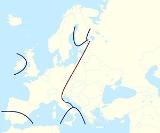
Hajnal line
Encyclopedia

Saint Petersburg
Saint Petersburg is a city and a federal subject of Russia located on the Neva River at the head of the Gulf of Finland on the Baltic Sea...
, Russia
Russia
Russia or , officially known as both Russia and the Russian Federation , is a country in northern Eurasia. It is a federal semi-presidential republic, comprising 83 federal subjects...
and Trieste
Trieste
Trieste is a city and seaport in northeastern Italy. It is situated towards the end of a narrow strip of land lying between the Adriatic Sea and Italy's border with Slovenia, which lies almost immediately south and east of the city...
, Italy
Italy
Italy , officially the Italian Republic languages]] under the European Charter for Regional or Minority Languages. In each of these, Italy's official name is as follows:;;;;;;;;), is a unitary parliamentary republic in South-Central Europe. To the north it borders France, Switzerland, Austria and...
. In 1965, John Hajnal
John Hajnal
John Hajnal, FBA , born John Hajnal-Kónyi, was a Hungarian-British academic in the fields of mathematics and economics .-Life:...
discovered it divides Europe
Europe
Europe is, by convention, one of the world's seven continents. Comprising the westernmost peninsula of Eurasia, Europe is generally 'divided' from Asia to its east by the watershed divides of the Ural and Caucasus Mountains, the Ural River, the Caspian and Black Seas, and the waterways connecting...
into two areas characterized by a different levels of nuptiality.
West of this line, the average age of women at first marriage was 24 or more, men 26, spouses were relatively close in age, and 10% or more of adults never married. East of the line, the mean age of both sexes at marriage was earlier, spousal age disparity was greater and marriage more nearly universal. Subsequent research has amply confirmed Hajnal's continental divide, and what has come to be known as the 'Western European marriage pattern', although historical demographers have also noted that there are significant variations within the region.
The Western European pattern of late and non-universal marriage restricted fertility massively, especially when it was coupled with very low levels of childbirth out of wedlock. Birth control took place by delaying marriage more than suppressing fertility within it. Women's life-phase from menarche
Menarche
Menarche is the first menstrual cycle, or first menstrual bleeding, in female human beings. From both social and medical perspectives it is often considered the central event of female puberty, as it signals the possibility of fertility....
to first birth was unusually long, averaging ten to twelve years.
The region's late marriage pattern has received considerable scholarly attention in part because it appears to be unique; it has not been found in any other part of the world prior to the Twentieth Century. The origins of the late marriage system are a matter of conjecture prior to the 16th Century when the demographic evidence from family reconstitution studies makes the prevalence of the pattern clear. Many historians have wondered whether this unique conjugal regime might explain, in part, why capitalism first took root in Northwestern Europe, contributing to the region's relatively low mortality rates, hastening the fragmentation of the peasantry and the precocious formation of a mobile class of landless wage-earners. Others have highlighted the significance of the late marriage pattern for gender relations, for the relative strength of women's position within marriage, the centrality of widows in village land inheritance, and the vitality of women's community networks.
Building on similar speculative literalism and typologism some authors have constructed a mirrored Eastern European pattern of early and universal marriage and high fertility rates, associated with the existence of complex family structures and patriarchal cultural traits, essentialized especially in Southeast Europe. Other authors, using standard ethnographic methods, traditional historical sources and aggregate demographic data, show the inadequacy of the traditional paradigm against the available empirical evidence and argue that the specific rationale for the myth of many children, high fertility rates and complex family structures in Southeast European context is an ideological elaboration of patriarchy, which is emphasized by practices of cultural activism rather than by supposedly embedded cultural patterns that culturally determine the social life of one or another people.

